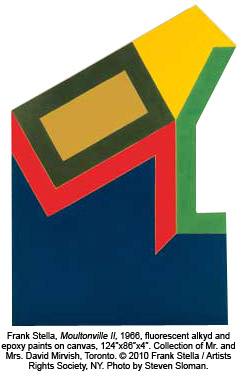Frank Stella: Irregular Polygons
Hood Museum of Art • Hanover, NH • www.hoodmuseum.dartmouth.edu • Through March 13, 2011
Assembled at the Hood Museum of Art is a representative selection of large shaped and painted canvases from Frank Stella’s Irregular Polygon series. These works are accompanied by preparatory drawings, some prints, and examples of the artist’s later works.  Viewers who go to the show to sample and confirm Stella’s long, innovative, and meritorious career in art will not be disappointed. And yet, there is something wholly unexpected to discover in the shaped canvases themselves.
Viewers who go to the show to sample and confirm Stella’s long, innovative, and meritorious career in art will not be disappointed. And yet, there is something wholly unexpected to discover in the shaped canvases themselves.
Stella’s Irregular Polygons are large, thick, asymmetrical canvases, composed of simple painted bands and geometric forms, and executed in limited, flat colors. Their visual impact is bold and minimal. However, if you’ve looked only at reproductions of Stella’s work, there is really nothing to prepare you for their audacious presence in real life. One of the unexpected pleasures of experiencing the Irregular Polygons in person involves the realization that the work’s presence is undiluted by concerns of polish or presentation.
Reproduced, the Irregular Polygons project a hard-edged slickness. In the way that Mondrian’s grids reveal themselves to the naked eye as almost quaintly marked and made, the Irregular Polygons are constructed with an unfussy vigor that avers the presence of their maker’s hand. For one, Stella’s canvases are unprimed, allowing their pigment to bleed outside of tape-guided lines. In addition, the chunky four-inch sides of their stretchers are unframed and crudely taped, revealing random marks and places where the canvases are ill-fitting or hastily sewn.
Of course it must be said that the unanticipated quality of touch in Stella’s abstractions will never dissuade us from experiencing the work as fundamentally conceptual rather than as expressive or marked. Many critics and connoisseurs have expanded on the idea that Stella’s shaped canvases abandon imagery ultimately to assert themselves purely as things. Standing before them, one agrees that it is this quality of physicality and “thingness” that (perhaps paradoxically) makes the Irregular Polygons conceptual.
Ultimately, the Irregular Polygons strike us as something like anti-Platonic forms. Suspended crudely and beautifully before us, they are simultaneously perfect and imperfect forms—the uncanny embodiments of a reality that we don’t see reflected in the visible world, but that we somehow apprehend the moment we stand before them.
—Rane Hall
